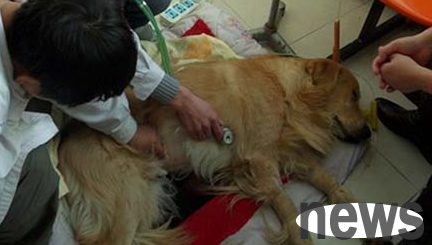Uremia in dogs refers to a body poisoning syndrome caused by the accumulation of metabolites and other toxic substances in the body due to the renal failure of the dog.
1. Causes of kyria uremia:
Uremia is a manifestation of severe renal failure in dogs, and its occurrence is related to the following factors.

1. The absorption of intestinal toxic substances, such as phenol, tyrosine, phenylacetide, etc., is absorbed into the blood by the intestine, and the detoxification function of the liver is reduced, and the poison accumulates in the blood, causing poisoning.
2. Due to renal failure, urea enters the intestinal cavity and is decomposed into ammonia and ammonium salts through intestinal bacteria, and is then absorbed into the blood, causing symptoms of nervous system poisoning.
3. The decomposition of toxic products of certain proteins, such as accumulation of guanidine compounds, can inhibit the activity of certain enzymes (lactate dehydrogenase, ATPase, etc.) in the body, resulting in convulsions in the dog, and can also induce gastroenteritis, pericarditis, bleeding and reduced immune function in dogs.
4. Acidosis occurs due to disorders of excretion of acid metabolites, causing changes in respiratory, cardiovascular activity and coma.
2. Symptoms of danuremia:
1. Due to the damage to various tissues and organs of dogs, their clinical symptoms are also complex and diverse. The sick dog is extremely depressed, has unclear consciousness, sensory disorders, drowsiness: loss of appetite or loss of appetite, vomiting, gastrointestinal inflammation, mucosal ulcers, diarrhea, bloody stools, intestinal paralysis: increased blood pressure, cardiac insufficiency, pulmonary edema, congestion, shallow and frequent breathing.
2. Due to metabolic disorders, the affected dog may manifest as dehydration, low sodium, calcium, and high potassium, phosphorus, and magnesemia, and significantly increase the non-protein nitrogen content in the blood, acidosis, and hyperlipidemia. Lower sugar tolerance and vitamin deficiency. Hyperphosphatemia further causes abnormal calcium metabolism, vitamin D deficiency, and dogs often have osteosofol and osteotrophic dystrophy, and can also secondary hyperparathyroidism. Due to the low immune function of dogs, they are prone to secondary infection.
3. Blood test, urea nitrogen is higher than 40 mg/100 ml, creatinine is higher than 4 mg/100 ml, and blood sugar, calcium and carbonate are lower. Increased blood potassium and phosphorus. 4. Urine examination. The kidneys have the functions of concentrating and diluting urine. During prerenal renal failure, the urine specific gravity is 1.025: the renal renal failure is 1.008--1.012, indicating that the renal concentration and dilution function is reduced: postrenal renal failure, and the urine specific gravity changes are uncertain. Oligouria and anuria are a sign of critical illness (normal, kazumari is 25-40 mg/kg body weight per day).

III. Treatment of kyria uremia:
1. General treatment. Substitute sodium bicarbonate according to the degree of acidosis (testing the binding capacity of plasma carbon dioxide), and select an infusion agent without calcium to adjust for hyperkalemia. Supplement large amounts of amino acids, high energy, vitamin preparations, etc. to improve hyperazoaemia. For dogs with prerenal uremia, furosemide is administered 2 to 4 mg/kg body weight, once every 8 to 12 hours. Or 1-2 mg/kg body weight of uric acid, administered in 2 times. When neurological symptoms occur. Chlopromazine is administered 10-20 mg/kg body weight or 2-5 mg/kg body weight of phenobarbital and taken orally three times a day.
2. Peritoneal dialysis. When urea nitrogen in the blood is 100 mg/100 ml, serum creatinine in 100 mg/100 ml, serum potassium 6 mmol/L, peritoneal dialysis can be purchased. Dialysate is a calcium-free liquid. Intermittent peritoneal perfusion method is relatively simple. For dogs with severe water retention, hypertonic sugar perfusion can be used. If the symptoms are relieved and the symptoms recur, it indicates that the kidneys completely lose function. Poor prognosis.
3. Intermittent peritoneal perfusion method: scissoring and disinfecting the abdominal wall, puncture with an ascites trocar, and insert a multi-porous cannula. Remove the cannula and insulate the cannula. After heating the perfusion solution, inject 50-150 ml/kg each time, and then stay for 40 minutes, drain the liquid naturally and repeat 2-3 times. The perfusion solution is usually made of sodium lactate compound preparation.
4. When pulmonary edema is severe, a compound preparation of glucose with high impregnation pressure and sodium lactate is used. Because the perfusion solution does not contain potassium chloride, 4 ml of potassium chloride (4 mmol/liter) will be added to each liter of perfusion solution.